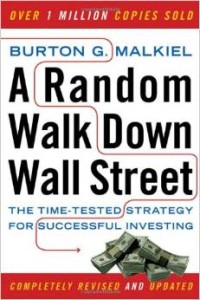“One ring to rule them all.” –JRR Tolkien, Lord of the Rings
A Random Walk Down Wall Street by Burton Malkiel literally changed my life. Back when I was an undergrad at the University of Pittsburgh, and I was showing a budding interest in finance, a professor recommended this book to me. I ripped through it in about two days. The concepts were so simple yet so complex. It made so much sense to me, and a light bulb totally went off in my head, completely shaping the way I have looked at investing for the past 20 years. If you’re going to read just one book on investing, this is the one you should read.
The book basically talks about two fundamental concepts of investing: what will happen in the future, and why some stocks (or asset classes) have higher returns than others. Combine these two and you pretty much have an airtight understanding of why the stock market does was it does.
Efficient Market Theory
The entire book is based on the concept that stocks follow a random walk which basically means that you can’t predict their movements, especially over the short term. Some days the market will go up, others down, and that pattern is totally random; in the same day some stocks will go up while others go down, and that is totally random. Because of the randomness, it’s impossible to predict when the stock market will move up or which individual stocks will perform best, so you might as well invest in an index fund with a buy and hold strategy (much more on this in a future post).

The theory rests on two core ideas:
- New information drives stock movements and that new information affects the prices nearly instantly. So if Tesla develops a new battery technology, once that news becomes public, Tesla’s stock will rise to reflect the new value of the information. A week, a day, an hour, or even a minute later, the market has already digested the information–the news has become old news.
- People only buy or sell stocks for what they think they’re worth. If Apple was trading at $120, but everyone knew it was really worth $140, no one would want to sell it for $120 but instead would only sell it for $140. If there were people stupid enough to do it, their shares would be bought instantly by people who knew the stock was worth more. This means that whatever price stocks are trading at is the “right” price.
The efficient market theory makes investing both much simpler and more comfortable. Simpler because you don’t have to waste countless hours trying to figure out if now is the right time to buy into the market or which stock will do best. The stock markets are completely unpredictable in the short term so now is as good a time as any.
Comfortable because any price you pay is the right price. You could buy a stock in a company you’ve never heard of in an industry you know nothing about, and market forces have done you the favor of ensuring it’s the right price. If the price was too high sellers would have dumped shares and brought it down, while if the price was too low buyers would have snatched up shares and brought it up. There’s a real load off—Thank you efficient market theory!!!
Risk-reward
Everything isn’t totally out of your control, and the book spends a lot of time discussing the one thing that investors can do to impact their returns—take on risk. If you like “eating well” and want bigger returns, you should purchase stocks that are fundamentally riskier; if you like “sleeping well” and want steadier returns, you should purchase stocks that are fundamentally less risky.
Use the example of Tesla and Wal-mart. Tesla is a fundamentally riskier stock: its technology is still novel and unproven, it’s entering a market with established competitors, and the legal system works against it (auto dealerships in New Jersey and Texas). Maybe they “win” and become a dominant auto maker, but maybe they’ll “lose” and go bankrupt. The downside is very real, so the upside has to be especially sweet to investors to compensate them for taking the risk. Contrast that with Wal-mart: it’s already the dominant player with enormous economies of scale and a proven strategy that has been consistently successful. If it “loses” it might be lower sales, but most people don’t expect it to go out of business. Since the Wal-mart’s downside isn’t nearly as grim as Tesla’s, the upside doesn’t have to be nearly as big. So over the long-term if you invested in a diversified portfolio of risky companies like Tesla, you would get a higher return than a diversified portfolio of less risky companies like Wal-mart (as always, I’m never predicting future stock movements).
Malkiel does an amazing job explaining these concepts (much better than I can in a thousand-word blog) and many others, and then shows how history has proven their accuracy with myriad examples. My copy is an earlier edition (I bought it used because I’m cheap) published in 1980s, and those concepts apply to today’s stock market just like they did 30 years ago. Subsequent editions have been updated to include the internet boom and bust of the late 1990s and early 2000s as well as the banking crisis of the late 2000s. There’s a part of me that almost wishes he wouldn’t come out with new editions (but I get it, republishing is a real cash cow for him) just so he can say, “Look, the things I wrote 40 years ago are exactly apply to what is happening now.”
So as you step into the pool of personal investing, this is an essential guide. It will undeniably change the way you look at investing (for the better), and it might even change the way you look at life (geez, you’d think I had a man-crush on Burton or something, but the book is that darn good). I unreservedly give it the maximum four stocky foxes.


4 thoughts to “Book review: A Random Walk Down Wall Street”